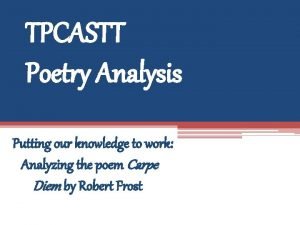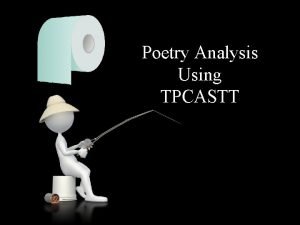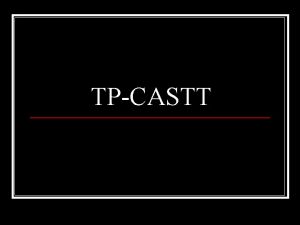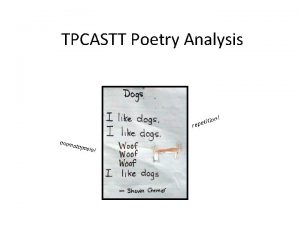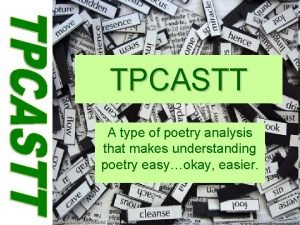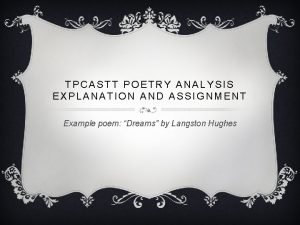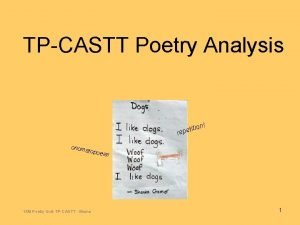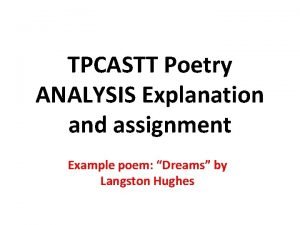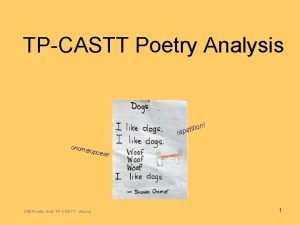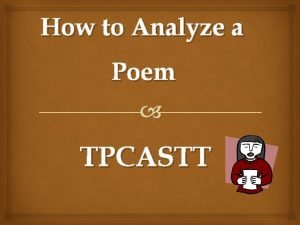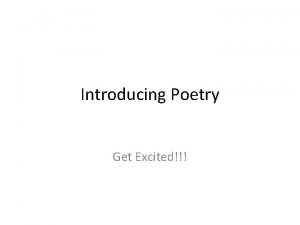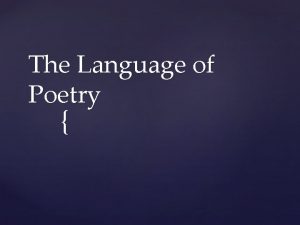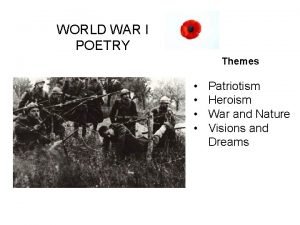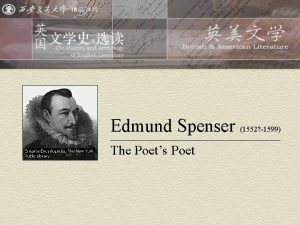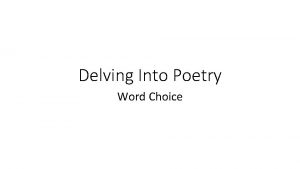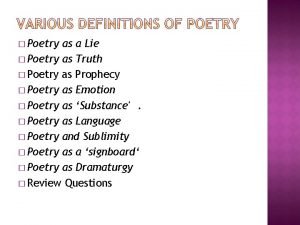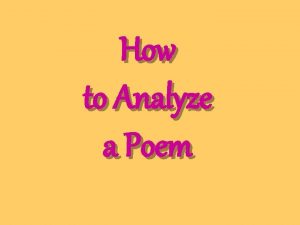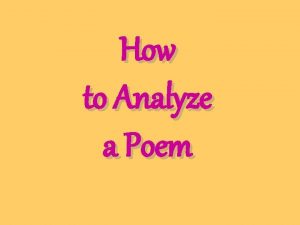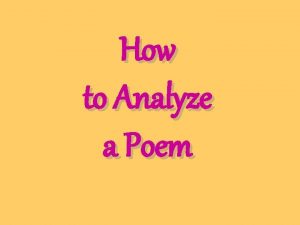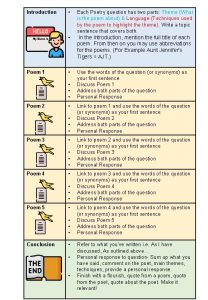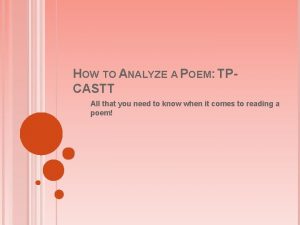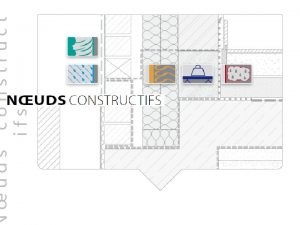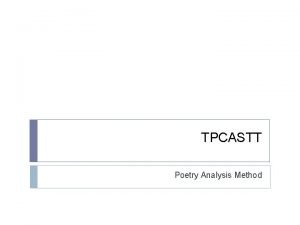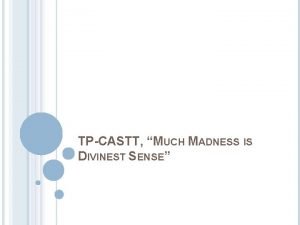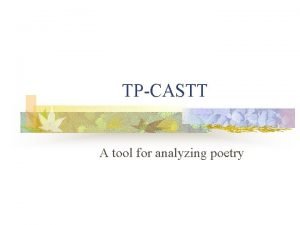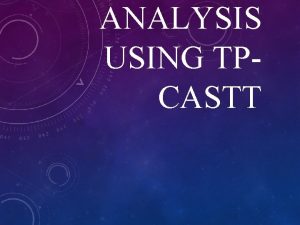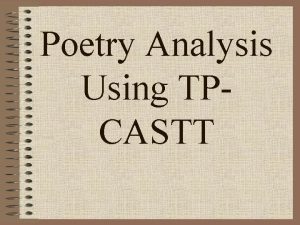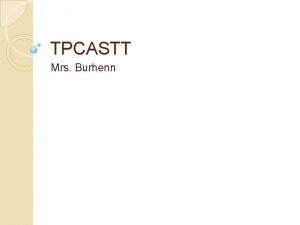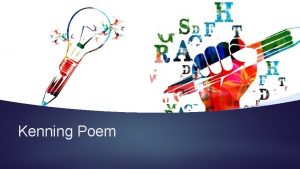How to Analyze a Poem TPCASTT Poets construct
















- Slides: 16

How to Analyze a Poem TPCASTT

Poets construct poems on purpose. Every word and space has meaning. All aspects (parts) of a poem contribute to the meaning. Most poems have many layers to uncover.

Step 1: Title Goal- Attempt to predict what the poem will be about Ponder the title before reading the poem. Questions to ask yourself: What predictions can I make about the poem? What feelings can I connect to the poem’s title? Write your response in a complete sentence

Step 2: Paraphrase Goal- Translate the poem, line by line, into your own words. FIRST READ IT OUT LOUD This is a must do! Read it straight through without stopping to analyze it to get a sense of how it sounds, how it works, what it might be about. Read from punctuation mark to punctuation mark, rather than line by line NOW… Paraphrase the literal meaning/plot of the poem. A true understanding of the poem must evolve from comprehension or what’s going on in the poem.

Step 3: Connotation Goal- Contemplate the poem for meaning beyond the literal meaning. In poetry, connotation indicates that analysts should examine any and all poetic devices, focusing on how such devices contribute to the meaning, the effect, or both of a poem. Consider imagery, figurative language, symbolism, diction, point of view, and sound devices You will link these considerations to the overall meaning.

Step 4: Attitude Goal- Observe both the speaker’s and the poet’s attitude Having examined the poem’s devices and clues closely, now explore the multiple attitudes that may be present in the poem. Here you will describe the tone of the author and/or speaker. Recall how this is done…

Step 5: Shifts Goal-Note shifts in the speaker’s attitudes or emotions. Rarely does a poet begin and end the poetic experience in the same place. Discovery of a poet’s understanding of an experience is critical to the understanding of the poem. Trace the feelings of the speaker from the beginning to the end, paying particular attention to the conclusion.

Look for the following to find shifts: 1. Key words (but, yet, however, although) 2. Punctuation (dashes, periods, colons, ellipsis) 3. Stanza division 4. Changes in line or stanza length or both 5. Irony (sometimes irony hides shifts) 6. Effect of structure on meaning 7. Changes in sound (rhyme) may indicate changes in meaning 8. Changes in diction (slang to formal language)

Step 6: Title Goal-Examine the title again, this time on an interpretive level Questions to ask yourself: Why is the title “_____? ” What does this mean?

Step 7: Theme Goal- Determine what the author is saying and wants me to learn and feel after reading the poem. Identify theme by recognizing the human experience, motivation, or condition suggested by the poem This step, within itself, has a system: 1) Summarize the plot 2) List the subject (s) of the poem (moving from literal subjects to abstract concepts such as war, death, discovery) 3) Determine what the poet is saying about each subject. Write a complete sentence, making a statement and point about the subject (s). **Now Turn your notes over so you can’t see them.

“Janet Waking” by John Crowe Ransom 1888– 1974 Beautifully Janet slept Till it was deeply morning. She woke then And thought about her dainty-feathered hen, To see how it had kept. One kiss she gave her mother, Only a small one gave she to her daddy Who would have kissed each curl of his shining baby; No kiss at all for her brother. “Old Chucky, Old Chucky!” she cried, Running across the world upon the grass To Chucky’s house, and listening. But alas, Her Chucky had died.

It was a transmogrifying bee Came droning down on Chucky’s old bald head And sat and put the poison. It scarcely bled, But how exceedingly And purply did the knot Swell with the venom and communicate Its rigour! Now the poor comb stood up straight But Chucky did not. So there was Janet Kneeling on the wet grass, crying her brown hen (Translated far beyond the daughters of men) To rise and walk upon it.

And weeping fast as she had breath Janet implored us, “Wake her from her sleep!” And would not be instructed in how deep Was the forgetful kingdom of death.

Example of theme using the poem “Janet Waking” In “Janet Waking” Janet awakens one morning and runs to greet her pet chicken only to discover that a bee had stung and killed the bird. The discovery desolates Janet to such a degree that her father cannot comfort her. Plot: Subjects: 1. A child’s first experience of death 2. loss of a pet 3. innocence Themes: 1. Children become aware of the inevitability of death and are transformed by the knowledge. 2. The death of innocence is inevitable

Rhyme Lyric Devices Same sounds End rhyme: the sounds at the ends of the lines are the same Internal rhyme—sounds within a line have the same pattern Rhyme scheme The pattern of rhyme: We designate the pattern with letters of the alphabet at the end of each line—abab or abba Alliteration Repetition of the same sounds: tongue twisters are alliteration Consonance is hard or consonant sounds Assonance is soft of vowel sounds Repetition Using the same word, phrase or image over and over Onomatopoeia When a word is spelled like it sounds woof— bark—hiccup— thump--sneeze

Symbols: When an object stands for an idea or another object Particular symbol—when the object has meaning only to a specific group of people Universal symbol- When a symbol has the same basic meaning to people of different cultures, geographies and times
 Tpcastt example poem
Tpcastt example poem Tpcastt example poem
Tpcastt example poem Tpcastt connotation examples
Tpcastt connotation examples Poem tpcastt example
Poem tpcastt example How to tpcastt
How to tpcastt Tpcast poem
Tpcast poem Tpcastt connotation examples
Tpcastt connotation examples Tpcastt poem
Tpcastt poem Quatrain poem
Quatrain poem Tpcastt definition
Tpcastt definition Magnifying glass illustration
Magnifying glass illustration Performance poets
Performance poets Poets choice of words
Poets choice of words The soldier rupert brooke analysis
The soldier rupert brooke analysis Edmund spenser poets poet
Edmund spenser poets poet It is the poet's choice of words
It is the poet's choice of words Poetry about lies
Poetry about lies
